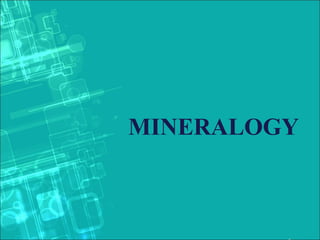Mineralogy
- 1. MINERALOGY
- 2. Introduction: • A mineral is a naturally occurring substance that is solid and inorganic representable by a chemical formula, and has an ordered atomic structure. • The study of minerals is called mineralogy. • There are over 4,900 known mineral species; over 4,660 of these have been approved by the International Mineralogical Association (IMA). • The silicate minerals compose over 90% of the Earth's crust.
- 4. Formation of minerals: • Minerals are crystalline solid substances, meaning the atoms making up a mineral are arranged in an ordered, three-dimensional, structure. • The distances and angles between an individual atom and the neighbors it is bonded to are constant. • The process of mineral formation is known as crystallization. In order for a mineral to crystallize, ions from the nearby environment must be brought together.
- 6. • A second process of mineral formation occurs during cooling of a melt. • When crystallization of this type takes place in water, we call it freezing. • Through a very similar mechanism, molten rock- forming liquids, known as magmas and lavas, cool and crystallize to form minerals and thus rocks.
- 9. Study of minerals: • Mineralogy is a subject of geology specializing in the scientific study of chemistry, crystal structure, and physical (including optical) properties of minerals. • Specific studies within mineralogy include the processes of mineral origin and formation, classification of minerals, their geographical distribution, as well as their utilization. The diamond crystal structure belongs to the face-centered cubic lattice, with a repeated
- 11. Physical properties: • The physical characteristics of minerals include traits which are used to identify and describe mineral species. These traits include color, streak, luster, density, hardness, cleavage, fracture, tenacity, and crystal • Color .Cleavage • Streak .Fracture • Luster . Tenacity • Density . Habit • Hardness

